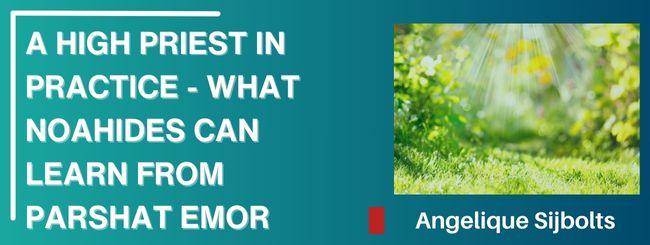בס”ד
A THOUGHT ABOUT PARSHAT EMOR 5785
In last week’s Torah portion, Acharei Mot, we find a remarkable statement in the Talmud (Bava Kamma 38a):
A non-Jew who dedicates himself to the study of Torah—that is, who learns and observes the Seven Noahide Laws and their details—is considered like a High Priest.
Rabbi Yirmiyah derives this from Leviticus 18:5:
“וָחַי בָּהֶם – so that the man shall live by them.”
The Torah doesn’t say “the Israelite” or “the priest,” but rather “הָאָדָם” (the human being). Rabbi Yirmiyah points out that this wording applies to all people—and therefore also to righteous non-Jews, or Noahides. According to him, this verse expresses a universal truth: even those who are not part of the Jewish people, but who dedicate themselves to G-d’s will, can attain great spiritual heights.
A Living Example
Parshat Emor builds on this idea. It describes how the priests—and especially the High Priest—must conduct themselves: they must maintain a refined appearance and are not permitted to publicly display mourning, such as tearing their garments or letting their hair grow wild. Why? Because they serve as a visible symbol of holiness—a living example to the community.
This holds a deep lesson for Noahides as well: we, too, can—and therefore must—be living examples for our families, communities, and broader society. Not only by faithfully observing the Seven Laws of Noah and their ramifications, but through how we treat others—with warmth, integrity, and presence. A righteous person is not only someone who avoids what is forbidden and fulfills their obligations, but someone who also acts as a mensch in the eyes of others—even if that sometimes means going far beyond what the law requires.
The Omer: Growth in Emotional Refinement
Parshat Emor falls during the period of the Counting of the Omer—the 49 days between Passover and Shavuot. For Jews, this is a Biblical commandment; for Noahides, it is not a mitzvah, but it offers valuable spiritual insights nonetheless.
The Lubavitcher Rebbe, Rabbi Menachem Mendel Schneerson, explains in Likkutei Sichot, Vol. 10 (pp. 295–296), and in Hayom Yom (10 Iyar), that the Counting of the Omer is more than just counting days—it’s a path of inner refinement. The Hebrew phrase “וּסְפַרְתֶּם לָכֶם” (“you shall count for yourselves”) can also be interpreted as: “You must make yourselves bright.”
“Purify yourselves until your inner holiness shines forth.”
– Hayom Yom, 10 Iyar
Each week of the Omer corresponds to one of the seven emotional attributes of the soul:
Chesed (Loving-kindness), Gevurah (Discipline/Strength), Tiferet (Harmony/Compassion), Netzach (Endurance), Hod (Humility), Yesod (Connection), and Malchut (Dignity/Leadership).
The goal of this period is not only to refine these traits individually but to bring them into balance with one another.
True spiritual growth occurs when we learn to integrate seeming opposites. Take, for example, Chesed and Gevurah: love without boundaries can become naïve or overwhelming, but discipline without compassion can be cold or harsh. Only when we learn to be lovingly firm and compassionately strong can we truly uplift others.
The same is true for other combinations:
Hod (humility) only becomes powerful when combined with Malchut (self-confidence and leadership); otherwise, one may shrink from responsibility.
And Netzach (persistence) becomes meaningful when paired with Tiferet (empathy and balance); otherwise, we may press on without purpose or connection.
The Counting of the Omer does not just teach us what to improve, but how to become balanced, integrated human beings—a true mensch.
From Fear to Love
The commentary of Ohr Chaim on Leviticus 18:4-5 helps us understand this journey of inner growth and motivation more deeply.
He notes that there are two distinct ways of serving G-d. Verse 4 calls upon us to follow the commandments out of a sense of duty or fear—an awareness of the consequences of failing to do what is right. This is emphasized by the verse’s conclusion:
“I am Hashem, your G-d (אֲנִי ה׳ אֱלֹקֵיכֶם),”
where the word “אֱלֹקֵיכֶם” refers to G-d’s aspect of justice and judgment.
But in verse 5, the tone shifts. It says:
“וָחַי בָּהֶם – so that the man shall live by them,”
and ends simply with:
“אֲנִי ה׳ – I am Hashem.”
Here, there is no reference to judgment, but rather to closeness and compassion. According to Ohr Chaim, this reflects a higher level of service—doing good not from fear of punishment, but from a deep, loving connection to G-d.
He further explains that such love-driven service brings blessing in both realms—in this world and the World to Come. The letter “ו” at the beginning of “וָחַי” (“and he shall live”) suggests that this life is more than just spiritual survival: it is a life enriched with meaning, connection, and divine grace.
In the broader context of Parshat Emor—and especially during the Omer—we can apply this to our own work of character development. Not because we must, but because we want to grow, to become better, and to bring more goodness into the world out of love.
Conclusion
The lessons of Parshat Emor and the Omer period are deep and universal. As Noahides, we too can become—like a High Priest—a living example of integrity, connection, and spiritual devotion in the eyes of those around us. By working on our inner attributes—not only out of obligation, but from a genuine love for what is good—we uplift ourselves and the world around us. In that sense, “וָחַי בָּהֶם – so that the man shall live by them” is not just a verse from an ancient book, but a living invitation to every person—to become a “High Priest” in everyday life.
By Angelique Sijbolts
With thanks to Rabbi Tuvia Serber for the feedback
Sources
Daily Wisdom of the Lubavitscher Rebbe
Emor, day 1 and 4
Ohr Chaim on Leviticus 18:5
© Copyright, all rights reserved. If you enjoyed this article, we encourage you to distribute it further.
Our blogs may contain text/quotes/references/links that include copyright material of Mechon-Mamre.org, Aish.com, Sefaria.org, Chabad.org, and/or AskNoah.org, which we use in accordance with their policies.
